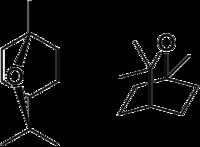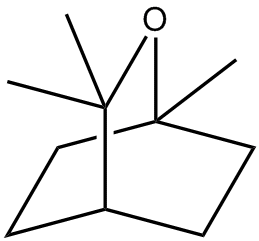Formula C10H18O Melting point 1.5 °C | Molar mass 154.249 g/mol Density 922 kg/m³ | |
 | ||
Eucalyptol is a natural organic compound that is a colorless liquid. It is a cyclic ether and a monoterpenoid.
Contents
- Composition
- Properties
- Flavoring and fragrance
- Medicinal
- Insecticide and repellent
- Toxicology
- Scientific study
- List of plants that contain the chemical
- Compendial status
- Sulfonation
- References

Eucalyptol is also known by a variety of synonyms: 1,8-cineol, 1,8-cineole, cajeputol, 1,8-epoxy-p-menthane, 1,8-oxido-p-menthane, eucalyptol, eucalyptole, 1,3,3-trimethyl-2-oxabicyclo[2,2,2]octane, cineol, cineole.

In 1870, F. S. Cloez identified and ascribed the name eucalyptol to the dominant portion of Eucalyptus globulus oil.
Composition

Eucalyptol comprises up to 90 percent of the essential oil of some species of the generic product Eucalyptus oil, hence the common name of the compound. It is also found in camphor laurel, bay leaves, tea tree, mugwort, sweet basil, wormwood, rosemary, common sage, Cannabis sativa and other aromatic plant foliage. Eucalyptol with a purity from 99.6 to 99.8 percent can be obtained in large quantities by fractional distillation of eucalyptus oil.
Although it can be used internally as a flavoring and medicine ingredient at very low doses, typical of many essential oils (volatile oils), eucalyptol is toxic if ingested at higher than normal doses.
Properties

Eucalyptol has a fresh mint-like smell and a spicy, cooling taste. It is insoluble in water, but miscible with ether, ethanol, and chloroform. The boiling point is 176 °C and the flash point is 49 °C. Eucalyptol forms crystalline adducts with hydrohalic acids, o-cresol, resorcinol, and phosphoric acid. Formation of these adducts are useful for purification.
Flavoring and fragrance
Because of its pleasant spicy aroma and taste, eucalyptol is used in flavorings, fragrances, and cosmetics. Cineole-based eucalyptus oil is used as a flavouring at low levels (0.002%) in various products, including baked goods, confectionery, meat products and beverages. In a 1994 report released by five top cigarette companies, eucalyptol was listed as one of the 599 additives to cigarettes. It is claimed that it is added to improve the flavor.
Medicinal
Eucalyptol is an ingredient in many brands of mouthwash and cough suppressant, as well as an inactive ingredient in body powder.
Insecticide and repellent
Eucalyptol is used as an insecticide and insect repellent.
In contrast, eucalyptol is one of many compounds that are attractive to males of various species of orchid bees, which gather the chemical to synthesize pheromones; it is commonly used as bait to attract and collect these bees for study. One such study with Euglossa imperialis, a non-social orchid bee species, has shown that the presence of cineole (also eucalyptol), elevates territorial behavior and specifically attracts the male bees. It was even observed that these males would periodically leave their territories to forage for chemicals such as cineole, thought to be important for attracting and mating with females, to synthesize pheromones.
Toxicology
In higher-than-normal doses, eucalyptol is hazardous via ingestion, skin contact, or inhalation. It can have acute health effects on behavior, respiratory tract, and nervous system. The acute oral LD50 is 2480 mg/kg (rat). It is classified as a reproductive toxin for females and a suspect reproductive toxin for males.
Scientific study
List of plants that contain the chemical
Compendial status
N.B. Listed as "cineole" in some pharmacopoeia.
